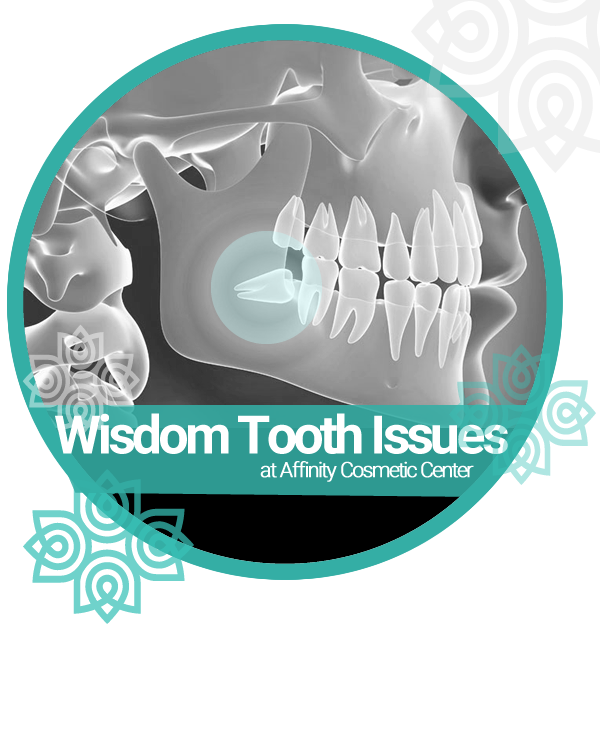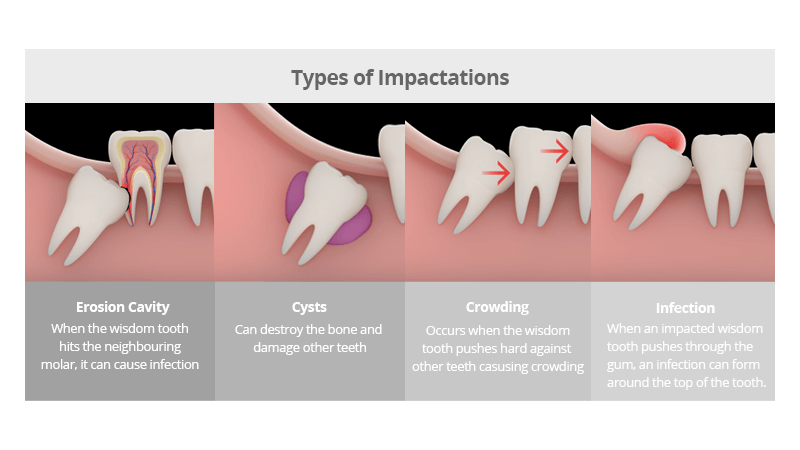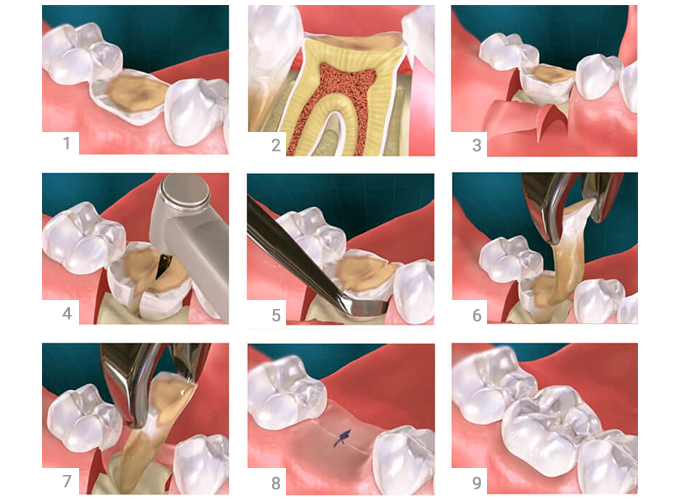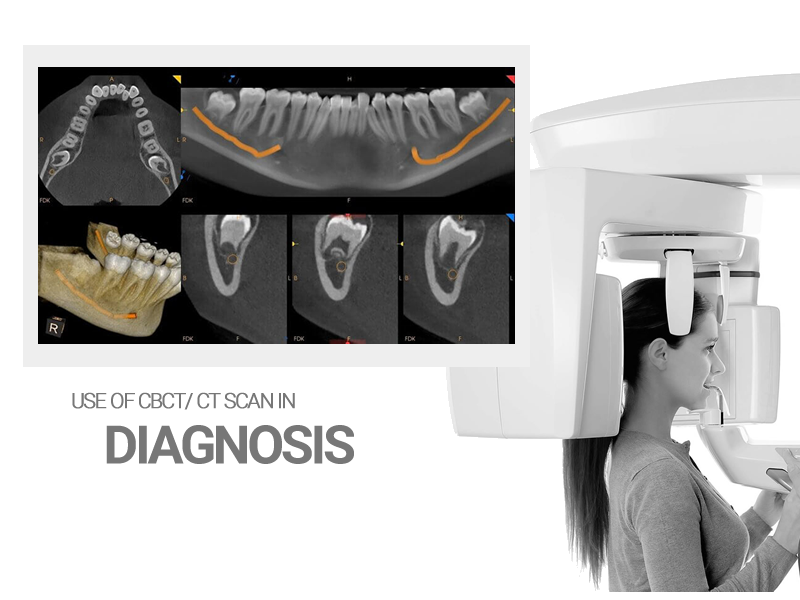
WISDOM TEETH EXTRACTION
THIRD MOLAR OR WISDOM TOOTH EXTRACTION IS A PROCESS OF EXTRACTING WISDOM TEETH THAT CAN BE ERUPTED, IMPACTED OR PARTIALLY IMPACTED AND CAN CAUSE DISCOMFORT, PAIN, AND SWELLING IF LEFT UNTREATED.
Wisdom teeth commonly affect other teeth as they develop, becoming impacted or “coming in sideways.” They are often extracted when this occurs.
At affinity dental group, we offer this service under normal condition or sedation dentistry depending on patients’ needs. We perform complete examination upon your arrival and use the latest in digital radiography to determine the safety of the procedure. Various options of sleep or sedation dentistry is also available.
WISDOM TEETH PROBLEMS
- Pain and Discomfort: Impacted wisdom teeth can cause pain, especially when they exert pressure on the surrounding teeth, gums, and jawbone. This pain can be intermittent or chronic.
- Infection: Partially erupted wisdom teeth can create an opening in the gum tissue that allows bacteria to enter and cause infection. This condition is known as pericoronitis and is often characterized by pain, swelling, redness, and an unpleasant taste or odor.
- Gum Inflammation: The flap of gum tissue that partially covers an impacted wisdom tooth can trap food particles and bacteria, leading to gum inflammation (gingivitis) and potential infection.
- Cysts and Tumors: Wisdom teeth that remain impacted can develop cysts or tumors within the jawbone. These growths can cause damage to the jawbone, adjacent teeth, and nerves.
- Damage to Adjacent Teeth: Impacted wisdom teeth can exert pressure on adjacent teeth, potentially causing crowding, shifting, or damage to these teeth.
- Decay and Cavities: Impacted wisdom teeth are often difficult to clean properly due to their positioning. This increases the risk of developing tooth decay (cavities) on the impacted teeth and the neighboring molars.
- Difficulty Chewing: Impacted wisdom teeth can affect your ability to chew properly, leading to discomfort and difficulty eating certain foods.
- Headaches and Jaw Pain: Impacted wisdom teeth can contribute to headaches, jaw pain (temporomandibular joint disorder or TMJ), and tension in the facial muscles.
- Sinus Issues: Upper wisdom teeth that are located close to the sinus cavity can cause sinus problems, including congestion, pain, and sinus infections.
- Alignment Issues: Wisdom teeth that are pushing against neighboring teeth can disrupt the alignment of your smile and undo the results of orthodontic treatment.
- Oral Hygiene Challenges: The presence of impacted wisdom teeth can make it challenging to clean properly around the affected area, increasing the risk of gum disease and other oral health issues.
- Speech Impediments: In some cases, the pressure from impacted wisdom teeth can affect the tongue’s movement and lead to speech difficulties.
USE OF CBCT IN WISDOM TOOTH EXTRACTION
1. Comprehensive Assessment: CBCT allows for a thorough assessment of the impacted wisdom teeth and their relationship to adjacent structures, such as neighboring teeth, nerves, sinuses, and bone. This three-dimensional perspective provides much more information than traditional two-dimensional X-rays, enabling a more accurate diagnosis.
2. Visualization of Impaction: CBCT images can clearly show the position and orientation of impacted wisdom teeth, whether they are mesially, distally, horizontally, or vertically impacted. This information is crucial for planning the surgical approach and understanding the potential risks and complications.
3. Assessment of Nerve Location: CBCT can accurately depict the proximity of wisdom teeth to important structures like the inferior alveolar nerve and lingual nerve. This helps the oral surgeon determine the safest and most effective approach for extraction to avoid nerve damage.
4. Evaluation of Bone Density and Volume: CBCT provides information about the quality and quantity of bone in the extraction site. This is important for planning the surgical technique, ensuring there is enough bone to support healing after the extraction.
5. Identification of Anomalies and Pathologies: CBCT images can reveal any anomalies, cysts, tumors, or other pathologies that may be associated with impacted wisdom teeth. Identifying these issues is crucial for comprehensive treatment planning.
6. Customized Treatment Planning: Based on the detailed CBCT images, the oral surgeon can develop a personalized treatment plan that considers the specific position of the impacted teeth, the patient’s anatomy, and potential risks.
7. Reducing Complications: CBCT helps in reducing the risk of complications by providing a clear visualization of the surgical area. Surgeons can anticipate challenges and plan their approach accordingly.
8. Communication with Patients: Using CBCT images, oral surgeons can visually explain the impaction, its severity, and the proposed treatment to patients. This enhances patient understanding and informed decision-making.
9. Minimizing Surgical Time: Having a thorough understanding of the anatomy through CBCT helps surgeons streamline the extraction process, potentially reducing surgical time.
10. Long-Term Planning: CBCT scans are often part of a patient’s dental record, providing valuable information for future treatment planning or reference.



















